But man does not live by GPU alone. If you want a high-end GPU, you must seek it on a high-end graphics card that may well be rife with other interesting upgrade features. Indeed, graphics cards themselves are feats of extreme engineering, marrying crafty circuit-board design to clever cooling strategies.
Today we look at three single-GPU graphics cards, each a unique marvel of engineering. Two cards are built around Nvidia's latest GTX 680 GPU, and the other incorporates AMD's latest Radeon HD 7970 GHz Edition. The GTX 680 focuses on delivering tremendous gaming performance, while the Radeon HD 7970 GHz Edition is strong at games but also provides excellent GPU performance for nongaming applications that can benefit from using a GPU for computational tasks.
Typically, Nvidia and AMD build reference boards with fairly conservative GPU and memory clock speeds. Card makers then take these reference designs, relabel them without changing much of anything, and offer them for sale. Lately, however, graphics card manufacturers have tried to differentiate themselves in a highly competitive market by creating their own board designs. These designs offer custom cooling, improved voltage regulation, and significantly higher core clock speeds than the reference designs do. Out of the box, they're faster than reference designs, but they also tend to be a little pricier.
The contenders
Let's take a look at a spec chart for these high-end graphics cards. Then we'll discuss each card individually in greater depth.| FEATURE | EVGA GTX 680 Classified | Asus GTX 680 DCII TOP | Sapphire Radeon HD 7970 Dual X OC |
| GPU | Nvidia GTX 680 | Nvidia GTX 680 | AMD Radeon HD 7970 GHz Edition |
| Core clock | 1111MHz | 1137MHz | 950MHz |
| Boost clock | 1176MHz | 1201MHz | 1000MHz |
| Video memory | 4GB (6008MHz) | 2GB (6008MHz) | 3GB (5800MHz) |
| Power connectors | Two 8-pin | One 8-pin, one 6-pin | One 8-pin, one 6-pin |
| Display connectors | One DP 1.2, one HDMI 1.4a, two DVI-Dual Link | One DP 1.2, one HDMI 1.4a, two DVI-Dual Link | One DP 1.2, one HDMI 1.4a, one DVI Dual Link, one DVI Single Link |
| Physical size (length/height/design style) | 10.5 inches/5.94 inches/double slot | 11.8 inches/5.1 inches/triple slot | 11.0 inches /4.72 inches/double slot |
| Price | $650 | $550 | $475 |
Now let's take a closer look at each card. Afterward, we'll dive into the performance test results.
EVGA GTX 680 Classified
The Classified series comprises the highest-performance air-cooled cards that EVGA offers.
Asus GTX 680 DCII TOP
The "DCII" in the name stands for "DirectCU II." Asus uses a direct-contact copper heat sink to assist in cooling the card.
In return you'll get one of the most aggressively factory-overclocked cards on the market. Despite the exceptional 1137MHz core clock (which exceeds 1.2GHz in boost mode), the card is exceptionally quiet. You can hear the dual cooling fans spin up under load, but the Asus card is noticeably quieter than the EVGA card. Though idle power is slightly lower, the higher boost clock leads to more-demanding power draw under load. So when the card is running under a heavy 3D-rendering load, it consumes about 30W more than the EVGA card does when similarly occupied.
Sapphire Radeon HD 7970 Dual X OC
The Sapphire Dual X is the only card of the three reviewed here that is based on AMD's Radeon HD 7970 GHz Edition—yet it doesn't quite clock at 1GHz, except under boost conditions.
As we'll see shortly, the Radeon HD 7970 GHz edition tends to consume more power under load than the GTX 680.
Performance
We ran all of our performance and power tests on our standard graphics test system, which has the following components and features:- 3.3GHz Intel Core i7 3960X CPU
- Asus P9X79 Deluxe motherboard
- Intel RT2011 sealed liquid CPU cooler
- 16GB Corsair DDR-1600 memory (quad-channel)
- Corsair AX1200 power supply
- 1TB Seagate 7200.12 hard-disk drive
- Asus Blu-ray reader/DVD writer
- Corsair Graphite 600T case
Our testing regimen includes two synthetic 3D benchmarks and six game benchmarks for evaluating performance:
- 3DMark 2011, which simulates game rendering and GPU compute tasks.
- Unigine Heaven, which can hammer a GPU's hardware tessellation engine.
- Crysis 2, run with hardware tessellation disabled, since the game's use of tessellation is poorly implemented.
- Total War: Shogun 2. Dialing up all of Shogun 2's features makes the game a serious memory hog when handling video.
- DiRT Showdown. The latest version of the DiRT racing franchise implements global illumination using GPU compute.
- DiRT 3. The older DiRT 3 test is more conventional in how it handles DirectX 11 rendering.
- Metro 2033. This older first-person shooter can still stress graphics cards.
- Batman: Arkham City. The sequel to the sleeper hit Arkham Asylum offers a series of fly-throughs at different levels to test graphics performance.
Performance results: Power
Few people use their PC exclusively for gaming, so it makes sense to test both idle performance and performance under 3D load. Idle performance is close to what you'll see from these cards when you run normal desktop applications on your system.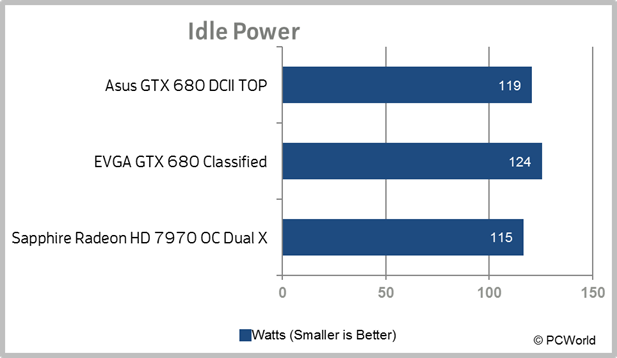
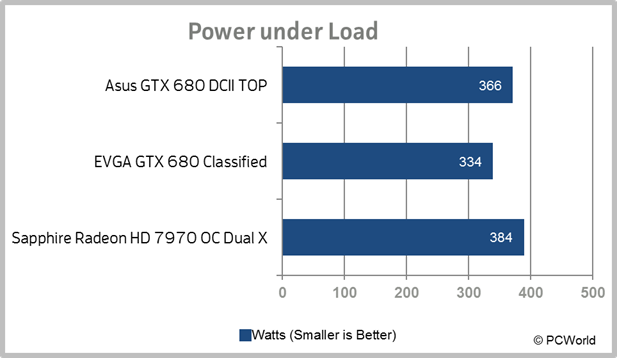
The Sapphire card was a little louder than the Asus card, but a little quieter than the EVGA GTX 680 Classified. All three cards were considerably less noisy than the previous generation's high-end cards, however. This is partly due to their improved power efficiency: These cards just don't get as hot as their predecessors did. In addition, the manufacturers have worked to tune their cooling systems to minimize more-noticeable, higher-frequency noise.
3DMark 2011 and Unigine Heaven
These two synthetic benchmarks make somewhat harsher demands on GPUs than most games do, though the type of load doesn't always reflect what modern games are doing. Think of these benchmarks as tests of potential, rather than real, performance.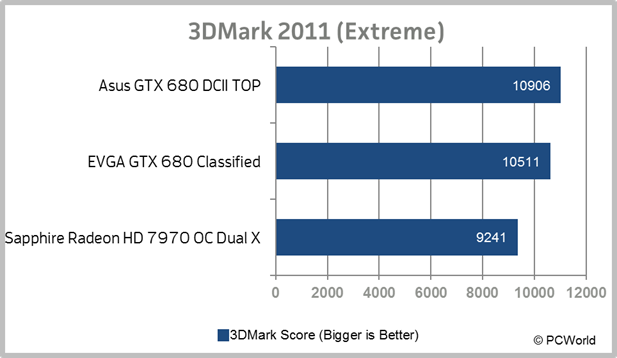
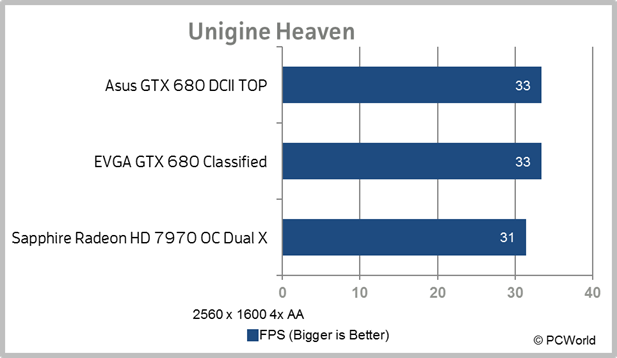
Game performance
When we look at the results of actual game testing, we see that performance differences tended to vary from game to game, depending on the kind of game load presented. Each game in our test suite approaches 3D rendering chores in its own way.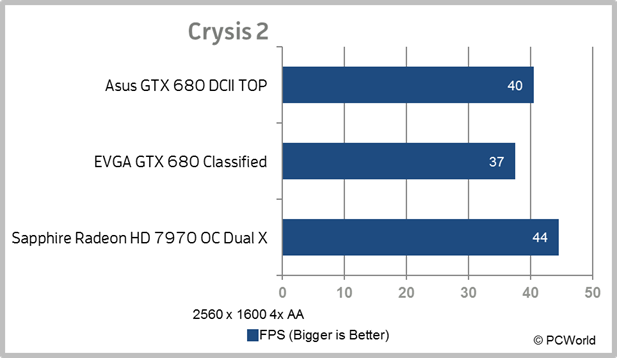
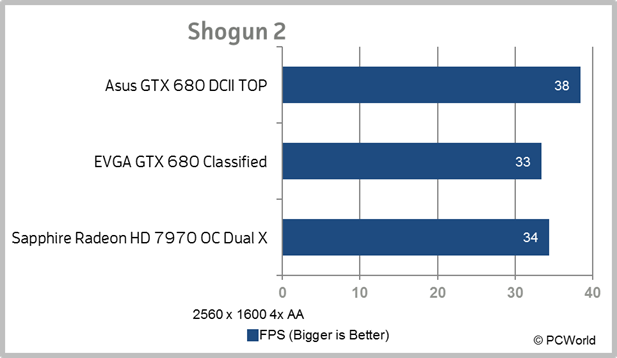
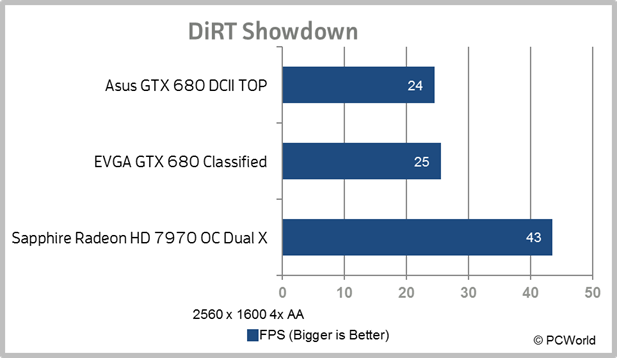
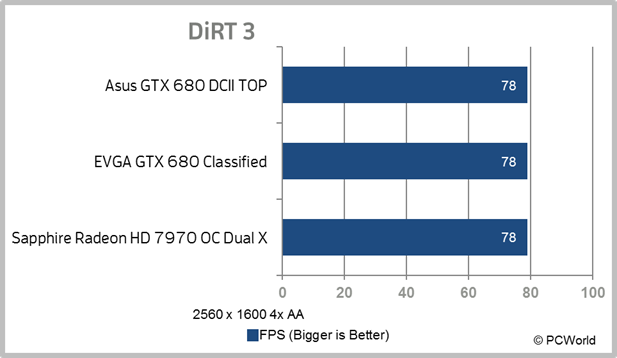
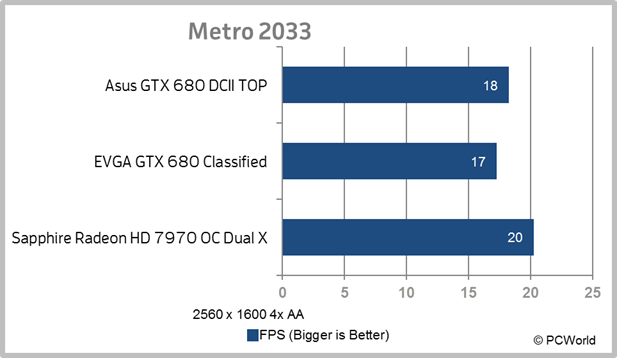
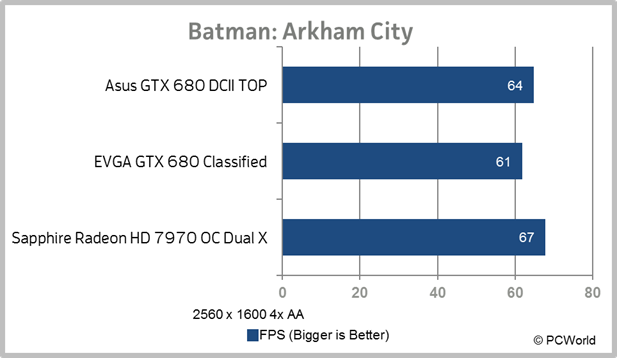
Bottom line
All three cards performed well on most games, and the differences between them were generally small. The outlier here involved DiRT Showdown—but elsewhere the results were pretty even.The EVGA GTX 680 Classified is an intriguing but ultimately imperfect card. It includes 4GB of video memory, so if you plan on running three 1080p monitors using Nivida's 3D Vision stereoscopic display technology, this card might be a good choice. On the other hand, the extra height makes it problematic to install in many cases—and it's a little noisier than the Asus card, too. The dual 8-pin power connectors might mean that you can manually overclock it to a greater extent, particularly with EVGA's excellent Precision X overclocking software; but many users may feel skittish about overclocking a GPU that's already pushed pretty hard.
At $475, the Sapphire Radeon HD 7970 Dual X OC wins the crown for best price/performance ratio. However, it consumes a little more power and makes a little noise than the Asus GTX 680 DCII TOP. I would be inclined to go with the Asus card based on noise levels alone. The massive Asus GTX 680 DCII TOP is about as quiet a high-end card as I've ever heard. And at $550, it costs substantially less than EVGA's Classified card. If you want the performance, but not the noise, of a high-end GPU, the Asus GTX 680 DCII TOP is a great choice.
Sign up here with your email

ConversionConversion EmoticonEmoticon